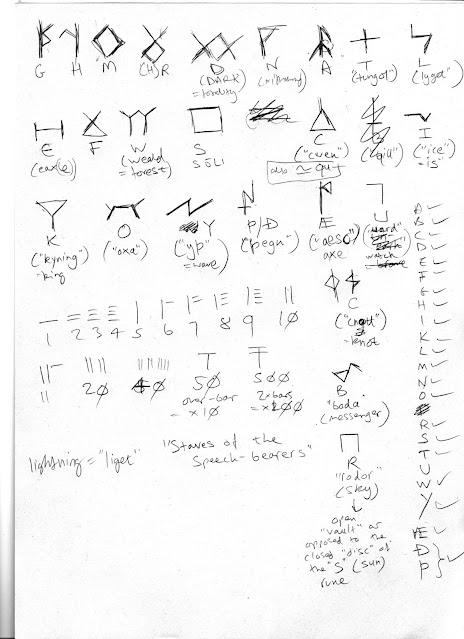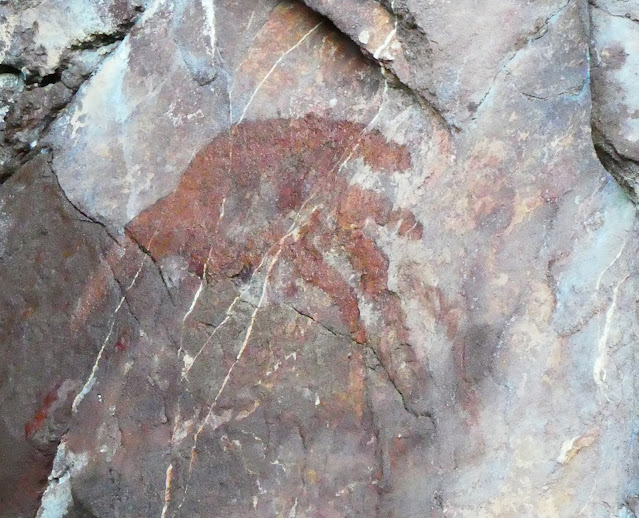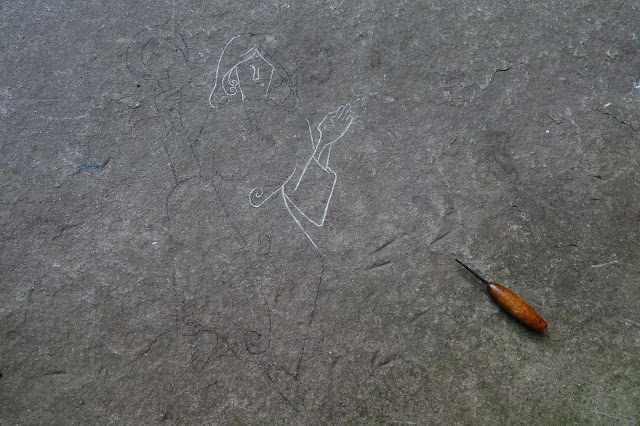Illuminating the Heroes...and More Runes
Getting back into serious work has been hard the past few days, but last night and this afternoon saw progress on the Gyldland Runic alphabet. First, the usable alphabet had to be defined - no Q, V, X, J or Z; no P (many words starting with 'P' in OE are Latin loan-words, and I wanted each Rune's name to have the initial letter which it represented), with additional characters for the 'specials', namely 'ash', and 'eth/thorn'. I set the six prime deities as the first six characters in the 'alphabet', with the others more or less randomly ordered as follows:
So some slight modifications there from the first rough draft, with a couple of alternatives as well for good measure. This Rune system is clearly showing its pictographic origins, with one of my favourites being the 'B' - boda, = 'messenger', i.e raven. The Germanic reference there for readers ought to be clear enough (cf. Hugin and Munin).
Also began a basic numbering system, suitably klunky as befits a non-Indo-Arabic influenced culture (even the Romans, for all their brilliance, never got their heads around the idea of 'zero'), with use limited probably to small-scale trading and accounts, recording heads of cattle and such rather than calculating complex engineering projects. (Looking at this again on-screen, I wondered: how would 1-4, which are already represented by horizontal bars, look if needed to be multiplied by 10 or 100 - which is done by adding a further horizontal bar on top? I decided that the multiplying bar would just need to be longer, to differentiate it...)
The next stage was to put these Runes to some use. It occurred to me today that I hadn't yet attempted visualizations of either of Womba's travel companions, Ffreow and Gifli. These were sketched (along with a 'warrior' version of Womba) during this morning's online class discussion:
 | |
| The Ulfish axe-warrior, Ffreow - whose name is spelled out in Gyldish Runes along the haft. |
As a skilleed engraver and smith, Ffreow may himself have been the creator of this self-congratulatory image, nicely showing off war-paint, élite warrior tattoo scheme and the foe-splitting great-axe, or delgr. Seeing the Runes written, they look rather like a cross between real Germanic Runes and later Egyptian hieroglyphics, or hieratic cursive forms, when the elaborate elementary pictographs had become stylized and simplified.
 |
| Womba with sword 'Icetongue' and Gifli, the priest of Hretha |
Class discussions on taxonomies and human definitions of 'Other' fuelled some thought too, which I'll return to when my mind's in a more academic mode of operation. I was especially happy with the rendering of Gifli, who somehow has just the right combination of world-weariness, sagacity and inscrutability, looking rather like an ancient Chinese sage or Zen master. The facial expression was also suggested by a memory of Simon Schama's description of ancient British bronze horse sculpture, whose elongated faces looked like "so many Eeyores having another bad day" (A History of Britain, BBC, 2000). The horns, too, are slightly suggestive of the Celtic 'Cernunos'/horned god type of imagery.
Looking at these characters again hours later and presented cleanly on-screen makes me wonder if I couldn't do something more clever with them than carve them into chunks of sandstone. They almost look like chess pieces (Womba as queen, and Gifli as bishop!), though again the feasibility of 3D rendering is probably out of reach with the limited time remaining. Clay, however, is always a half-way option...




Comments
Post a Comment